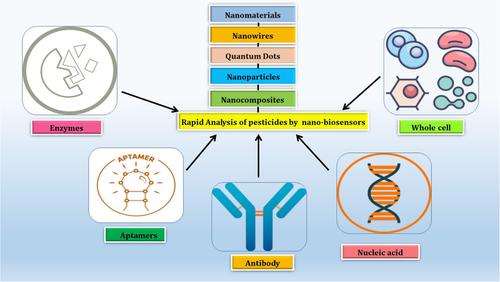当前位置:
X-MOL 学术
›
Biotechnol. Bioeng.
›
论文详情
Our official English website, www.x-mol.net, welcomes your feedback! (Note: you will need to create a separate account there.)
Nanobiosensors based on on-site detection approaches for rapid pesticide sensing in the agricultural arena: A systematic review of the current status and perspectives
Biotechnology and Bioengineering ( IF 3.5 ) Pub Date : 2024-06-10 , DOI: 10.1002/bit.28764 Subramani Srinivasan 1, 2 , Devarajan Raajasubramanian 3, 4 , Natarajan Ashokkumar 1 , Veerasamy Vinothkumar 1 , Nagarajan Paramaguru 5 , Palanisamy Selvaraj 1 , Ambothi Kanagalakshimi 1, 2 , Kuppan Narendra 3 , Chinna Krishnan Shanmuga Sundaram 6 , Raju Murali 1, 2
Biotechnology and Bioengineering ( IF 3.5 ) Pub Date : 2024-06-10 , DOI: 10.1002/bit.28764 Subramani Srinivasan 1, 2 , Devarajan Raajasubramanian 3, 4 , Natarajan Ashokkumar 1 , Veerasamy Vinothkumar 1 , Nagarajan Paramaguru 5 , Palanisamy Selvaraj 1 , Ambothi Kanagalakshimi 1, 2 , Kuppan Narendra 3 , Chinna Krishnan Shanmuga Sundaram 6 , Raju Murali 1, 2
Affiliation

|
The extensive use of chemical pesticides has significantly boosted agricultural food crop yields. Nevertheless, their excessive and unregulated application has resulted in food contamination and pollution in environmental, aquatic, and agricultural ecosystems. Consequently, the on-site monitoring of pesticide residues in agricultural practices is paramount to safeguard global food and conservational safety. Traditional pesticide detection methods are cumbersome and ill-suited for on-site pesticide finding. The systematic review provides an in-depth analysis of the current status and perspectives of nanobiosensors (NBS) for pesticide detection in the agricultural arena. Furthermore, the study encompasses the fundamental principles of NBS, the various transduction mechanisms employed, and their incorporation into on-site detection platforms. Conversely, the assortment of transduction mechanisms, including optical, electrochemical, and piezoelectric tactics, is deliberated in detail, emphasizing its advantages and limitations in pesticide perception. Incorporating NBS into on-site detection platforms confirms a vital feature of their pertinence. The evaluation reflects the integration of NBS into lab-on-a-chip systems, handheld devices, and wireless sensor networks, permitting real-time monitoring and data-driven decision-making in agronomic settings. The potential for robotics and automation in pesticide detection is also scrutinized, highlighting their role in improving competence and accuracy. Finally, this systematic review provides a complete understanding of the current landscape of NBS for on-site pesticide sensing. Consequently, we anticipate that this review offers valuable insights that could form the foundation for creating innovative NBS applicable in various fields such as materials science, nanoscience, food technology and environmental science.
中文翻译:

基于现场检测方法的纳米生物传感器在农业领域用于快速农药传感:对现状和前景的系统回顾
化学农药的大量使用,显着提高了农业粮食作物的产量。然而,它们的过度和不受管制的应用导致了食品污染以及环境、水生和农业生态系统的污染。因此,农业实践中农药残留的现场监测对于保障全球食品和保护安全至关重要。传统的农药检测方法繁琐且不适合现场发现农药。该系统综述对农业领域农药检测纳米生物传感器(NBS)的现状和前景进行了深入分析。此外,该研究还涵盖了 NBS 的基本原理、所采用的各种转导机制以及将其纳入现场检测平台。相反,详细讨论了各种转导机制,包括光学、电化学和压电策略,强调其在农药感知方面的优点和局限性。将 NBS 纳入现场检测平台证实了其相关性的一个重要特征。该评估反映了 NBS 与芯片实验室系统、手持设备和无线传感器网络的集成,从而允许在农艺环境中进行实时监测和数据驱动的决策。机器人和自动化在农药检测中的潜力也受到了仔细审查,强调了它们在提高能力和准确性方面的作用。最后,本系统综述提供了对 NBS 现场农药传感现状的完整了解。 因此,我们预计这篇综述提供了宝贵的见解,可以为创建适用于材料科学、纳米科学、食品技术和环境科学等各个领域的创新 NBS 奠定基础。
更新日期:2024-06-10
中文翻译:

基于现场检测方法的纳米生物传感器在农业领域用于快速农药传感:对现状和前景的系统回顾
化学农药的大量使用,显着提高了农业粮食作物的产量。然而,它们的过度和不受管制的应用导致了食品污染以及环境、水生和农业生态系统的污染。因此,农业实践中农药残留的现场监测对于保障全球食品和保护安全至关重要。传统的农药检测方法繁琐且不适合现场发现农药。该系统综述对农业领域农药检测纳米生物传感器(NBS)的现状和前景进行了深入分析。此外,该研究还涵盖了 NBS 的基本原理、所采用的各种转导机制以及将其纳入现场检测平台。相反,详细讨论了各种转导机制,包括光学、电化学和压电策略,强调其在农药感知方面的优点和局限性。将 NBS 纳入现场检测平台证实了其相关性的一个重要特征。该评估反映了 NBS 与芯片实验室系统、手持设备和无线传感器网络的集成,从而允许在农艺环境中进行实时监测和数据驱动的决策。机器人和自动化在农药检测中的潜力也受到了仔细审查,强调了它们在提高能力和准确性方面的作用。最后,本系统综述提供了对 NBS 现场农药传感现状的完整了解。 因此,我们预计这篇综述提供了宝贵的见解,可以为创建适用于材料科学、纳米科学、食品技术和环境科学等各个领域的创新 NBS 奠定基础。











































 京公网安备 11010802027423号
京公网安备 11010802027423号